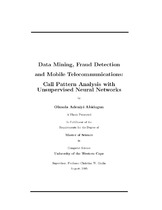| dc.contributor.advisor | Omlin, Christian W.P. | |
| dc.contributor.author | Abidogun, Olusola Adeniyi | |
| dc.contributor.other | Dept. of Computer Science | |
| dc.contributor.other | Faculty of Science | |
| dc.date.accessioned | 2013-05-27T12:59:32Z | |
| dc.date.available | 2007/03/16 12:25 | |
| dc.date.available | 2007/03/16 | |
| dc.date.available | 2013-05-27T12:59:32Z | |
| dc.date.issued | 2005 | |
| dc.identifier.uri | http://hdl.handle.net/11394/249 | |
| dc.description | Magister Scientiae - MSc | en_US |
| dc.description.abstract | Huge amounts of data are being collected as a result of the increased use of mobile telecommunications. Insight into information and knowledge derived from these databases can give operators a competitive edge in terms of customer care and retention, marketing and fraud detection. One of the strategies for fraud detection checks for signs of questionable changes in user behavior. Although the intentions of the mobile phone users cannot be observed, their intentions are reflected in the call data which define usage patterns. Over a period of time, an individual phone generates a large pattern of use. While call data are recorded for subscribers for billing purposes, we are making no prior assumptions about the data indicative of fraudulent call patterns, i.e. the calls made for billing purpose are unlabeled. Further analysis is thus, required to be able to isolate fraudulent usage. An unsupervised learning algorithm can analyse and cluster call patterns for each subscriber in order to facilitate the fraud detection process. This research investigates the unsupervised learning potentials of two neural networks for the profiling of calls made by users over a period of time in a mobile telecommunication network. Our study provides a comparative analysis and application of Self-Organizing Maps (SOM) and Long Short-Term Memory (LSTM) recurrent neural networks algorithms to user call data records in order to conduct a descriptive data mining on users call patterns. Our investigation shows the learning ability of both techniques to discriminate user call patterns; the LSTM recurrent neural network algorithm providing a better discrimination than the SOM algorithm in terms of long time series modelling. LSTM discriminates different types of temporal sequences and groups them according to a variety of features. The ordered features can later be interpreted and labeled according to specific requirements of the mobile service provider. Thus, suspicious call behaviours are isolated within the mobile telecommunication network and can be used to to identify fraudulent call patterns. We give results using masked call data from a real mobile telecommunication network. | en_US |
| dc.language.iso | en | en_US |
| dc.publisher | University of the Western Cape | en_US |
| dc.subject | Cellular telephone systems | en_US |
| dc.subject | Mobile communication systems | en_US |
| dc.subject | Neural networks (Computer science) | en_US |
| dc.title | Data mining, fraud detection and mobile telecommunications: call pattern analysis with unsupervised neural networks | en_US |
| dc.type | Thesis | en_US |
| dc.rights.holder | University of the Western Cape | en_US |
| dc.description.country | South Africa | |

